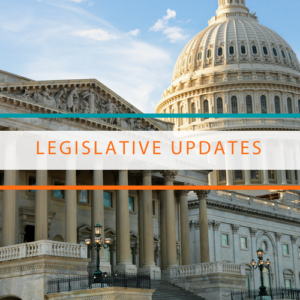This week, Congress has continued to make modest progress on appropriations legislation for the federal government while lawmakers and President Biden have begun to consider how to manage the coming use of artificial intelligence (AI) technologies.
Congress No Closer to Agreement on Fiscal Year 2024 (FY24) Education Spending
 With new House Speaker Mike Johnson (R-LA) in place and another possible government shutdown only two weeks away, a new sense of urgency has swept Capitol Hill as lawmakers worked to pass several appropriations measures in both chambers this week. In the House, the Labor, Health and Human Services, Education, and Related Agencies (Labor-HHS-ED) appropriations bill — legislation that provides funding for the Carl D. Perkins Career and Technical Education Act (Perkins V) and other important Career Technical Education (CTE) related investments—has been moved directly to the House floor for consideration and a vote is scheduled sometime the week of November 13. As a reminder, if enacted, this proposal would reduce funding for Title I of the Every Students Succeeds Act (ESSA) by 80 percent and would substantially cut funding or entirely eliminate many other education and workforce development programs like the Workforce Innovation and Opportunity Act (WIOA).
With new House Speaker Mike Johnson (R-LA) in place and another possible government shutdown only two weeks away, a new sense of urgency has swept Capitol Hill as lawmakers worked to pass several appropriations measures in both chambers this week. In the House, the Labor, Health and Human Services, Education, and Related Agencies (Labor-HHS-ED) appropriations bill — legislation that provides funding for the Carl D. Perkins Career and Technical Education Act (Perkins V) and other important Career Technical Education (CTE) related investments—has been moved directly to the House floor for consideration and a vote is scheduled sometime the week of November 13. As a reminder, if enacted, this proposal would reduce funding for Title I of the Every Students Succeeds Act (ESSA) by 80 percent and would substantially cut funding or entirely eliminate many other education and workforce development programs like the Workforce Innovation and Opportunity Act (WIOA).
The Senate has not yet scheduled further consideration of its own version of this legislation which most recently advanced out of the Appropriations Committee and is awaiting consideration by the upper chamber. Unlike the House version of this legislation, which would freeze current funding for Perkins V’s basic state grant program, the Senate’s proposal would provide a much-needed $43 million increase in support for the primary federal investment in CTE.
Under the new leadership of Speaker Johnson, the House has continued to pass other spending proposals that would drastically cut federal funding for a variety of programs, falling well below the topline spending targets outlined in the Fiscal Responsibility Act (FRA) — a bipartisan agreement that was passed by Congress earlier this year which avoided a catastrophic default on the nation’s debt obligations. At the same time, the Senate has continued to advance spending proposals that conform to the FRA agreement. With both chambers proposing wildly different visions for FY24 funding, it remains unclear how lawmakers will move forward by the middle of this month. Unless agreement can be reached by the beginning of 2024, an across-the-board sequester cut to all federal programs, mandated by the FRA, will come into effect. As these efforts continue to unfold, Advance CTE is continuing to work with partners on Capitol Hill to ensure the funding needs of the wider CTE education community are met as part of this process.
Biden Administration Unveils Artificial Intelligence Executive Order
On Monday, October 30, President Biden issued a wide-ranging Executive Order regarding the “Safe, Secure, and Trustworthy Development and Use of Artificial Intelligence” (AI). The measure has several components of note for the CTE community including how to support workers displaced by AI, strategies for attracting and retaining AI talent and directing federal agencies to explore how to strengthen or expand pathways programs leading into AI or adjacent occupational fields. The Executive Order also directs the U.S. Department of Education (ED) to develop resources, policies, and guidance on AI in education within one year and similarly directs the Departments of Labor, Commerce and others to produce similar recommendations on legislative and regulatory actions that can better support workers and learners navigate a world changed by the implementation of AI and related technologies. Learn more about these efforts in this factsheet.
Senate Examines AI’s Impact on the Workforce
Earlier this week, the Senate Health, Education, Labor and Pensions’ Subcommittee on Employment and Workforce Safety held a hearing titled, “AI and the Future of Work: Moving Forward Together.” The hearing featured testimony from witnesses representing the private sector and explored the potential impacts that AI will likely have on work as well as potential strategies to mitigate negative effects. A key theme of the hearing centered on the growing importance of lifelong learning, including the need to reform ways that the federal government supports learners pursuing postsecondary education. To that end, Senator Kaine (D-VA) highlighted the importance of Congress passing the JOBS Act – legislation that would expand Pell Grant eligibility for high-quality, shorter-term CTE programs.
ED Distributes New Funding for Educator Diversity and Compensation Efforts
Late last week, the U.S. ED announced that it was awarding $115 million in new funding via the Teacher and School Leader Incentive Program — an initiative authorized by ESSA. These funds will support nearly 30 projects that aim to address teacher shortages while also increasing instructional staff diversity. This investment “… will help states and school districts recruit and retain new talent, increase compensation, and address educator shortages that we know disproportionately impact students from our communities of color, students from low-income backgrounds, students with disabilities and English learners,” U.S. Secretary of Education Miguel Cardona said, in part, as part of the announcement.
Steve Voytek, Policy Advisor
